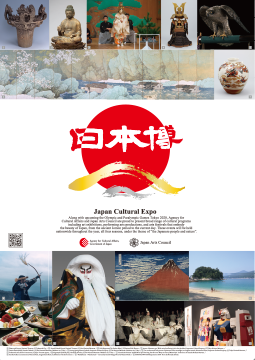Home > Highlighting JAPAN > Highlighting Japan September 2019 > Celebrating Diversity in Culture
Highlighting JAPAN

Inheriting and Creating Culture
Capitalizing on the opportunity of the 2020 Olympic and Paralympic Games, the Japan Cultural Expo is being held to showcase the appeal of Japanese culture and art. We spoke with Junko Kawamura, President of the Japan Arts Council and Secretary-General of the Japan Cultural Expo Secretariat, about the characteristics of Japanese culture and the Japan Cultural Expo project.
What are the characteristics of Japanese culture?
One of the characteristics of Japanese culture is the length of time it occupies. Japanese culture is highly diverse, extending from earthenware and earthen figures created during the Jomon period which is more than 10,000 years ago to the anime, manga and art based on cutting-edge technologies seen in modern Japan. In these aspects of culture there are many cases of techniques and sensibilities being carried over from ancient times into the modern world. Creators of anime and manga are sometimes inspired to devise new ideas and techniques based on picture scrolls drawn in the twelfth or thirteenth centuries. Meanwhile, the acting and performances of kabuki theater have had an influence on movies and tv programs and video games. Some actors and actresses even incorporate the steps of actors in noh theater into their stage performances. In Japan, one can see both culture that has been passed down over a long time, and culture that has been newly created using those elements as an inspiration.
What kinds of changes have you seen in relation to Japanese culture in recent years?
Pop culture and media arts have gained popularity overseas. For example, for the latest iteration of the Japan Media Arts Festival that has been held by the Agency for Cultural Affairs since 1997, works were received from more than 100 countries and regions. Previously, award winners from overseas have expressed delight in being able to win awards in Japan, the home of anime and manga. Many visitors decide to study in Japan due to their interest in manga and anime, and the number of overseas tourists who visit the regions featured in those works has increased significantly.
Japanese culture in regional areas has also attracted attention. Programs that combine the rich nature of regional areas with culture and art are being implemented in various regions. Notable examples of such endeavors are the Echigo-Tsumari Art Triennale and Setouchi Triennale, both of which have attracted considerable attention from Japan and overseas alike.
Recent years have seen a significant change that the Japanese people come to strongly recognize various powers of culture such as the power of connecting people with one another, the power to elicit people’s potential and the power to revitalize regional areas.
Tell us more about the Japan Cultural Expo that started in March this year.
The Japan Cultural Expo is being held nationwide prior to, throughout and after the 2020 Olympic and Paralympic Games in Tokyo. The overarching theme is “Humanity and Nature in Japan,” the primary aim of which is to introduce Japanese styles of thinking such as a reverence towards and coexistence with nature, that have existed from the Jomon period through to the present day as embodied in art by way of projects such as art exhibitions and stage performances. The Japan Cultural Expo is expected to further cultural development and lead to the creation of social and economic value by promoting exchanges with people in Japan and overseas. The projects being implemented under the Expo number in the several hundreds. For example, at the Kyushu National Museum, an exhibition of Jomon period earthenware will be run from October to December this year. In addition, the Okinawa-based musical theater, Kumiodori, which is celebrating the 300th anniversary of its first performance this year, will go on a national tour from October to November. Next year, exhibitions covering a wide range of areas will be held, including projects to disseminate the culture of the Ainu, Japan’s indigenous peoples, as well as elements of Japanese cuisine, architecture, kogei crafts, fashion and manga that have been cultivated through the Japanese affinity for nature. Performances and new operas that combine a wide array of the arts will also be on display.
What elements of Japanese culture do you think should be disseminated throughout Japan and overseas moving forward?
It is important that more people learn of the techniques and people that support Japanese culture. To pass on traditional culture to future generations, the related skills also need to be passed on from person to person. The skills needed to repair artistic works such as temples and Buddhist statues, and the skills to create clothing and traditional objects of traditional performing arts are examples of this. At an exhibition of national treasures that will be held in Kyoto from April 2020 as a Japan Cultural Expo project, we also plan to introduce the processes involved in repairing works of art and old documents. We also have plans to hold an exhibition of models of Japanese representative architecture from the Asuka period to modern times and to show repair work on buildings of cultural properties to the public. We believe these endeavors are necessary to ensure the continuation and development of Japanese culture.
© 2009 Cabinet Office, Government of Japan








